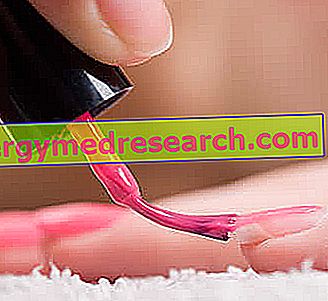Watch the video
X Watch the video on youtubeClean your ears
Proper ear cleaning is essential to minimize the risk of infection and prevent the appearance of ear wax caps. As we know, the ears are extremely fragile sensory organs, therefore they require a delicate but at the same time adequate and effective cleaning.
Ear cleaning should be performed even more meticulously by people whose hearing can be altered or compromised. In this category of subjects we recall:
- Workers who, exercising their activity in environments with high noise pollution (eg DJs, workers in the road sector etc.), are forced to use earplugs;
- Swimmers: penetrating inside the ear canal, the water tends to swell the grains of wax that increasing in volume end up hindering the ear canal;
- Bearers of hearing aids: the elderly, protagonists of this category, should pay particular attention to cleaning the ears, since the hearing aids can favor the stagnation of earwax in the basin of the auricle.

The above does not mean that care should not be taken in the hygiene of the ears, rather the cleaning of the auditory organs is correct when it is performed with diligence and attention.
Proper ear cleaning
Ear cleansing consists of a series of treatments aimed at facilitating the expulsion of earwax accumulations from the inside to the outside of the auricle. We remind you that the simple movement of the jaw promotes the natural elimination of earwax granules, therefore it is advisable to perform this movement regularly, even several times during the day.
Beyond similar techniques, today numerous strategies are available aimed at cleaning the ears: however, the most suitable and best treatment aimed at removing the earwax has not yet been identified.
Below are the methods most used for ear cleaning.
Emollient / lubricating drops
Also known as water softeners or ceruminolytics, the emollient drops to be instilled directly into the auricle of the ear are particularly useful for dissolving the compacted wax particles, thus favoring their leakage.

The emollient drops can be formulated with natural oils (olive oil, sweet almond oil, vaseline oil, peanut oil) fortified with essential oils (disinfectants), or consisting of hydrogen peroxide, urea, glycerine or peroxide of carbamide.
For the cleaning of ears clogged with wax plugs it is advisable to apply a few emollient drops directly into the ear canal, twice a day. Continue the treatment for 3-6 days.
To prevent ear waxing, ear cleaning should be performed by instilling a few softening drops into the ear once a week.
Irrigation or washing
After softening the earwax with specific emollient drops, it is possible to proceed with a treatment widely used for ear cleaning: irrigation (otherwise called washing).
How to perform this method?
- Fill a syringe (with the needle removed) with warm water (37-38 ° C)
- Pull the ear up slightly to facilitate the entry of water into the ear canal
- Direct the nozzle of the water-filled syringe slightly upwards, towards the ear canal, to facilitate the subsequent exit of the ear wax
- Spray the water
- Tilt your head slightly to encourage water and wax particles to escape
This operation can be repeated several times.
Precautions
- Although earwashing is a fairly simple maneuver, care must be taken during execution, given the risks of breaking the tympanic membrane or tearing the skin of the ear canal.
- Use lukewarm water for proper ear cleaning: the use of water that is too cold or too hot compared to body temperature can cause dizziness
- Do not wash the ear in case of otitis or eardrum perforation: a similar attitude can create severe pain and dizziness.
- The water jet used to remove the wax should be sprayed more gently in children
- Suddenly stop the procedure if the patient complains of severe dizziness, nausea or severe pain during irrigation
Curettage

The curette is a special curved instrument used by the doctor to remove the ear plug accumulated in the ear. The curette is equipped with a particular "protective" end, very useful to prevent the doctor from entering too deeply into the ear canal.
Aspiration of earwax
Even the aspiration of earwax is part of the list of useful treatments for cleaning the ears. This method consists of the literal aspiration of the wax by means of a special cannula connected to a suction device. The operation must be performed by an expert on the subject: this is a second choice practice, generally used in case of contraindications to ear irrigation.
Wax cones or candles
The effectiveness and usefulness of the wax cones for the correct cleaning of the ears is doubtful: they are particular waxed-canvas cones which, placed directly in the ear cavity, remove the earwax through a sort of "chimney effect", after having turned them on like a candle.
The wax cones, about 20 cm long, have two open ends:
- The narrow end should be placed directly in the conch of the auricle, after tilting the head sideways on a rigid surface (preferably). In general, this end ends with a sort of saucer, to protect the skin from the fall of any residual hot wax.
- The wider end should be lit like a candle. The heat released by the combustion of the waxed cone softens the earwax, simultaneously giving rise to a depression inside the ear: by doing so, the content of the ear is sucked outwards.
- To extinguish the flame, gently remove the cone, and immerse the candle in a glass of water.
The use of wax cones for cleaning the ears is unreliable: the "cleaning" mechanism of the candles is not clear and the medical profession is against and wary of the use of this practice. The most important risk derived from this method is that the candle residues are deposited directly in the ear canal, creating a real plug of wax, much more difficult to remove than the earwax cap. And don't forget the risk of skin burns and hair fires!
Cotton sticks
It is recommended NOT to use cotton-coated sticks (the so-called cotton swabs) to clean the ears: the pressure of the stick exerted with "mechanical" pushes may even aggravate the pre-existing condition, favoring the accumulation of earwax rather than its removal . A similar behavior, in fact, tends to compact the wax, thus forming a cork.
In addition to what has been described, the "cleaning" of the ears with cotton sticks can damage the skin of the ear canal - already extremely fragile in itself - therefore favoring the engraftment by harmful bacteria and particles. Cotton swabs should only be used for cleaning the external ear.
risks
The neglect of ear hygiene can weigh heavily on the health of these very important organs. In fact, the accumulation of earwax can cause problems of varying severity, including the physical obstruction of the ear canal which has a negative effect on hearing ability. The major defendant is the wax plug which, as we know, is responsible for a series of problems:
- Tinnitus (ringing in the ears)
- Bad ears
- Perception of "muffled" sounds
- Progressive hearing loss and hearing loss
- Rejoicing of his own voice
- Sensation of auricular fullness
- Dizziness and feeling of instability (similar symptoms, even if lighter, of labyrinthitis)
Do not forget, however, that incorrect ear cleaning increases the risk of local infection, therefore otitis and inflammatory stenosis of the external auditory canal. To preserve the perfect hearing ability, it is therefore essential to dedicate a few minutes of your time regularly to cleaning the ears.



